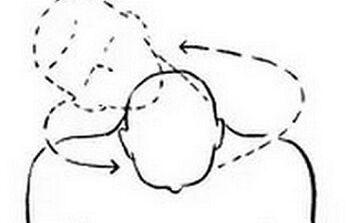
In women and middle -aged men, osteochondrosis of the cervical spine (SHOP) is diagnosed most often, because this department is more susceptible to loads.The first signs of the disease are often unexpressed, therefore it is difficult to determine the problem at the initial stages of development.
The manifestation of osteochondrosis is associated with the influence of many factors on the body.In order for the treatment regimen to be adequate osteochondrosis, it is important to find out the root cause of the occurrence.
The main reasons provoking the ailment
Cervical osteochondrosis is a pathology of degenerative-dystrophic nature, in which, under the influence of negative factors, the fabrics of the intervertebral discs in the neck.Over time, the disease affects other structures of the spine, as a result of which there is a violation of its functioning.Unpleasant symptoms begin to bother the person, the state of health is gradually deteriorating.
The main cause of vertebral degeneration is a violation of metabolic functions in the body.The vertebrae and intervertebral structures do not receive the necessary beneficial substances and elements.Bone growth-oosteophyte appears on bone tissues.Over time, ossification spreads.The neglected osteochondrosis leads to the fact that the cervical spine, due to the fusion of the vertebrae, becomes immobilized.
The trigger mechanism for the development of such processes is negative factors that constantly affect the human body.
The causes of osteochondrosis are the following:
- congenital pathologies of the structure of the musculoskeletal system;
- hereditary predisposition;
- heavy physical activity;
- sedentary lifestyle;
- violation of posture;
- back injuries;
- scoliosis;
- stresses, nervous overstarms;
- Complication after severe infectious diseases.
Degree of disease and manifestation
The initial stage of the disease is characterized by periodic headaches.
Signs of osteochondrosis of the cervical spine develop gradually.As pathology progresses, the symptoms become more pronounced.
Distinguish 4 stages of development of chondrosis:

- There are no obvious symptoms of osteochondrosis to 1 degree.Sometimes a headache can be disturbed, as well as discomfort in the neck.Symptoms quickly pass after rest, but degenerative processes have already begun in the discs, in which the integrity of the pulpoose nucleus is violated.
- When the pathology switched to the 2nd stage of the intervertebral cartilage is covered with cracks, through which the disk core goes out.The intervertebral space is reduced, the patient complains of acute pain of a chronic shape.
- At the 3rd stage of progression, osteochondrosis of the cervical region is characterized by severe vertebrates and headaches.Due to hypoxia, brain cells suffer, a person may have temporary paralysis of the limbs, problems with hearing and vision appear.On the cervical area there are hernias that squeeze nerves, muscles, arteries and veins.
- When the ailment to the last (4 tbsp.) Symptoms of cervical osteochondrosis in men and women become so pronounced that the patient cannot relax and rest even for a minute.Osteophytes form on the vertebrae, due to which the mobility of the neck is disturbed, a person becomes disabled.If you do not start comprehensive treatment at this stage, the situation may result in death.
Characteristic symptoms
You need to pay attention to your health if problems with the vestibular apparatus have begun.
Osteochondrosis of 1-2 degrees is effectively treated conservatively.In advanced cases, it is difficult to fully restore the destroyed intervertebral structures.This means that the disease is important to diagnose in the initial stages.Therefore, it is urgent to see a doctor if a person has a similar symptoms:
- acute pain discomfort, which is localized in the neck, shoulders, nape;
- severe headaches and dizziness arising due to the squeezing of the nerves and vessels of the cervical unit;
- violation of visual and auditory functions;
- weakness in the muscles;
- Numbness, the feeling that goosebumps are running along the skin;
- The functioning of the vestibular apparatus.
Cervical osteochondrosis at the level of C4 -C6 vertebrae is characterized by a violation of the sensitivity of the upper extremities, hands and fingers.If the vertebral artery is compressed, dangerous disorders that occur in the brain are worried.Due to the lack of blood supply and nutrition of brain cells, hypoxia occurs.If you do not be treated in a timely manner, the patient will begin to have memory problems, the swallowing function will be disturbed, and squeezing in the throat where the kadyk is located will be disturbed.
Often, even a voice changes in a person, and with the progression of cervical-thoracic osteochondrosis, heart pathologies occur.
How is diagnostics carried out?

At the reception, a neurologist by palpation determines whether there is a displacement of the vertebrae.
If a person suspects that he develops osteochondrosis of the cervical vertebra, it is necessary to visit a neuropathologist who will conduct an initial examination and try to find out the main causes of the development of the disease.During palpation, it is approximate to determine the stage of pathology, as it proceeds - with or without displacement.
To confirm the diagnosis, the patient will need to undergo a number of such instrumental diagnostic studies:
- X -ray.It will help to determine the degree of growth of osteophytes, the size of the inter -muddy gap.
- MRI or CT.Allows you to evaluate the degree of destruction of the intervertebral discs, as well as the state of other soft structures.
- Ultrasound with Doppler.It helps to determine the violations in the functioning of blood vessels, due to which the blood supply to the brain worsens.
How to treat the problem?
If during the diagnosis the diagnosis is confirmed, on the basis of the results obtained, the doctor selects the optimal treatment for cervical osteochondrosis.If the disease is not running, you can get rid of it with medicines and using auxiliary procedures.At 3-4 stages, drugs are often powerless, the best solution in this case is surgical surgery.
Effective medicine
Drug treatment of osteochondrosis of the cervical spine in the acute period is primarily aimed at relieving inflammation, swelling and relief of pain.
For these purposes, the following groups of drugs are prescribed:
- Non -steroidal anti -inflammatory drugs.Eliminate inflammation, help reduce swelling, stop pain.With exacerbation of pathology, it is recommended to use in the form of injections, when the symptoms are slightly subsided, you can drink tablets.
- Painkillers.With severe pains, they help to quickly anesthetize and alleviate the condition.
- Musorelaxants.Remove muscle spasm, so that nerves and blood vessels are freed.
- Chondroprotectors.Restore damaged cartilage structures, prevent their further destruction.For a positive effect, the drugs of this group are recommended to take a long period.
- Vasodilators.They contribute to improving blood flow, so that the nutrition of the brain is normalized.
- B vitamins V.Normalize the metabolism in the body, stimulate immunity, due to which soft and bone tissues regenerate faster.
LFK complex

With such a disease, it is useful to make rotational movements of the head.
With the help of medical exercises, it will be possible to quickly restore the affected structures of the cervical region.
You can cure the disease by performing the following approaches:
- turning the head in different directions;
- rotational movements;
- rotation shoulders;
- Raising and lowering the head.
Physiotherapy and massage
Cervical osteochondrosis is successfully treated using physiotherapeutic procedures that the doctor prescribes, taking into account the individual characteristics of the body.
Most often, it is recommended to take such courses:
- magnetotherapy;
- laser heating;
- ultrasound;
- electrophoresis;
- applications with ozokerite;
- hydrogen sulfide and radon baths;
- Ultraviolet irradiation.
In case of damage to osteochondrosis of the cervical region, it is useful to undergo a course of therapeutic manual massage.The procedure should be carried out by a trained doctor who previously familiarized himself with the diagnosis and radiographic pictures.Thanks to the point effect, stroking, patting and vibration, it will be possible to restore normal blood circulation, and establish the nutrition of damaged areas.
Treatment with folk remedies
You can treat cervical osteochondrosis with non -traditional methods, but you should first consult a doctor.
To relieve pain, inflammation and swelling will help a compress that is prepared according to this recipe:
- Wash the cabbage sheet, cut the rough fibers, knead well.
- Apply a mixture of honey and aloe juice (2: 1) to the sheet, evenly distribute on the surface.
- Warm up the compress above the steam, then attach to the neck, fixing with cling film and woolen scarf.
- Wear the bandage for 3-4 hours.
It is recommended to make a compress daily - in the morning and evening.
Prevention and forecast
With timely and adequate therapy, the disease can be cured and complicated.If the problem is not to treat and ignore the advice of a doctor, the forecast for restoration is disappointing.As a prevention of cervical osteochondrosis, it is important to lead an active lifestyle, monitor posture, do exercises, eat right, consult a doctor in a timely manner.
























